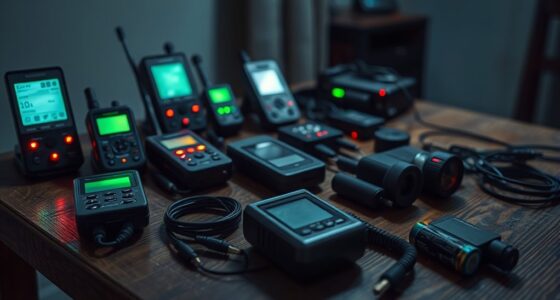Our debunking workflow focuses on thorough source verification and myth analysis to guarantee accuracy and credibility. You examine each source’s origin, authorship, and evidence, preventing reliance on outdated or false information. Then, you break down claims to understand their roots, identify misconceptions, and evaluate supporting details. As new data emerges, you revisit your sources and refine your analysis. Keep exploring the process to discover how this approach helps maintain trustworthy, well-informed insights.
Key Takeaways
- We systematically verify sources by examining origin, authorship, publication date, and supporting evidence.
- We analyze myths by breaking down claims to identify misconceptions and false assumptions.
- Our workflow involves continuous re-evaluation of sources to ensure information remains current and accurate.
- We dissect claims in their free-floating state to uncover inaccuracies without external influence.
- Transparency is maintained through detailed documentation of verification and myth analysis steps for ongoing improvement.

Have you ever wondered if your workflow is truly efficient or just filled with misconceptions? When it comes to streamlining your processes, one of the biggest pitfalls is accepting information at face value. That’s why source verification plays such a vital role in our debunking workflow. Instead of relying on hearsay or outdated data, we rigorously check the credibility of every source before integrating it into our analysis. This step ensures that what we’re working with is accurate, relevant, and trustworthy. We don’t just skim through references; we scrutinize the origin, authorship, publication date, and supporting evidence behind each piece of information. This thorough source verification acts as the foundation upon which we build our myth analysis, helping us identify misconceptions and false assumptions with confidence.
In the context of Free Floating, understanding the natural and unanchored state of information allows us to better evaluate the validity of claims without the influence of external structures. When we approach a claim or idea, we don’t immediately accept it as fact. Instead, we engage in myth analysis, which involves breaking down the assertion to understand its roots and uncover any underlying inaccuracies. This process is deliberate and methodical. We ask questions like: Where did this idea originate? Is there supporting evidence, or is it based on anecdotal or outdated information? Are there conflicting reports or alternative perspectives? By dissecting the claim through myth analysis, we can pinpoint exactly where misconceptions have taken hold. This clarity allows us to correct course and eliminate inaccuracies from our workflow, preventing the spread of misinformation and guaranteeing that our conclusions are based on solid facts.
Our debunking workflow is designed to be dynamic and iterative. It’s not a one-and-done process; rather, we continuously revisit and verify sources as new information emerges. This ongoing validation keeps our analysis current and accurate. We also prioritize transparency, documenting our source verification and myth analysis steps so others can follow our reasoning. This transparency not only fosters trust but also helps identify any blind spots or biases in our process. Ultimately, by emphasizing source verification and myth analysis, we create a robust framework that refutes misconceptions efficiently and effectively. It’s about cutting through the noise and guaranteeing that every part of your workflow rests on a solid, verified foundation, helping you work smarter, not harder.
Frequently Asked Questions
How Do We Prioritize Which Claims to Investigate First?
You prioritize claims based on source credibility and potential impact. Start by evaluating the credibility of the source, giving higher priority to those with a history of accuracy. Then, evaluate the evidence supporting the claim, focusing on the strength and reliability of the evidence. Urgent or widely circulated claims also get higher priority. By combining source credibility and evidence evaluation, you ensure you address the most significant and credible misinformation first.
What Tools Are Essential in Our Debunking Process?
Think of your tools like a detective’s kit—crucial and versatile. You need reliable sources for evaluation, such as trusted fact-checking sites and reputable databases. Digital tools like reverse image searches and browser extensions help verify claims swiftly. These tools, combined with fact-checking techniques, enable you to scrutinize information effectively, ensuring you spot falsehoods quickly and confidently. They’re your essential arsenal in the fight against misinformation.
How Do We Handle Sources With Conflicting Information?
When you encounter sources with conflicting information, you should first evaluate each source carefully, focusing on source evaluation and bias detection. Check their credibility, author expertise, and whether they present evidence objectively. If discrepancies remain, cross-reference with trusted, fact-checked sources to determine the most accurate information. This process helps you identify biases and guarantee you rely on the most reliable and balanced data available.
What Are Common Challenges Faced During Debunking?
You often face challenges like misinformation patterns that are deeply ingrained and hard to change. Psychological biases, such as confirmation bias, make it tough for people to accept facts that contradict their beliefs. You also encounter emotional reactions that hinder rational discussions. Staying patient and understanding these biases helps you craft effective responses, but these hurdles remain common in the debunking process, demanding persistence and empathy.
How Do We Verify the Credibility of New Sources?
To verify the credibility of new sources, you evaluate them using credibility criteria like author expertise, publication reputation, and evidence provided. You check the source’s background, look for bias, and cross-reference facts with reputable outlets. By applying these source evaluation techniques, you guarantee the information is trustworthy before sharing or relying on it. This process helps you maintain accuracy and avoid spreading misinformation.
Conclusion
Now that you’ve seen how our debunking workflow works like a well-oiled machine, you’re ready to tackle misinformation head-on. Think of it as steering a tricky sea—staying steady, checking your compass, and cutting through the waves of falsehoods. With each step, you become more confident in your ability to separate fact from fiction. Remember, every myth you bust is like shining a flashlight into the dark corners of misinformation, guiding others to the truth.








